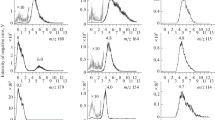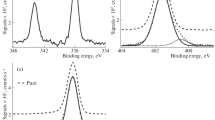Abstract
Electron attachment spectroscopy is employed to demonstrate that the scattering of slow (0–15 eV) electrons from perylenetetracarboxilic dianhydride (PTCDA) molecules in the gas phase leads to the resonant formation of molecular and fragment negative ions detected in the mass-spectrometric experiment. Depending on the electron energy, currents of anions have clearly manifested peaks at 0.14, 1.9, 3.0, 4.8, and 5.7 eV. In addition, resonant states are also detected at thermal energy (0 eV) of scattered electrons, as well as at 0.4 and 1.0 eV, as shoulders on experimental curves. The spectroscopic states of PTCDA anions at energies exceeding 0 eV are interpreted in terms of the formation of shape resonances on the basis of calculated values of energies of π*-type unoccupied molecular orbitals. It is found that the positions of unoccupied orbitals of an isolated PTCDA molecule correspond to the peaks in the density of states of the conduction band of PTCDA films provided that the energies of the orbitals are shifted by 1.4 eV. The latter value can be interpreted as the binding energy of a molecule in the film due to the polarization interaction with the surroundings.
Similar content being viewed by others
References
S. R. Forrest, Chem. Rev. 97, 1793 (1997).
F. S. Tautz, Prog. Surf. Sci. 82, 479 (2007).
S. Günes, H. Neugebauer, and N. S. Saricigtci, Chem. Rev. 107, 1324 (2007).
Q. H. Wang and M. C. Hersam, Nature Chem. 1, 206 (2009).
A. S. Komolov, E. F. Lazneva, and S. N. Akhremtchik, Appl. Surf. Sci. 256, 2419 (2010).
A. O. Morozov, T. U. Kampen, and D. R. T. Zahn, Surf. Sci. 446, 193 (2000).
A. S. Komolov, P. J. Møller, Y. G. Aliaev, S. Akhremtchik, and K. Schaumburg, J. Mol. Struct. 744–747, 145 (2005).
A. S. Komolov, P. J. Møller, J. Mortensen, et al., Appl. Surf. Sci. 253, 7376 (2007).
A. S. Komolov, P. J. Møller, and E. F. Lazneva, J. Electron Spectrosc. Relat. Phenom. 131–132, 67 (2003).
M. Allan, J. Electron Spectrosc. Relat. Phenom. 48, 219 (1989).
V. I. Khvostenko, Mass Spectrometry of Negative Ions in Organic Chemistry (Nauka, Moscow, 1981) [in Russian].
E. Illenberger and B. M. Smirnov, Usp. Fiz. Nauk. 168, 731 (1998) [Phys. Usp. 41, 651 (1998)].
G. J. Schultz, Rev. Mod. Phys. 45/3, 423 (1973).
L. G. Christophorou, Electron-Molecule Interactions and Their Applications (Academic, Orlando, 1984).
R. E. Palmer and P. J. Rous, Rev. Mod. Phys. 64/2, 383 (1992).
S. A. Pshenichnyuk, N. L. Asfandiarov, and A. V. Kukhto, Khim. Fiz. 26(7), 5 (2007).
M. J. Frisch, G. W. Trucks, H. B. Schlegel, et al., Gaussian 03, Revision D.01 (Gaussian Inc., Wallingford, 2004).
A. D. Becke, J. Chem. Phys. 98, 5648 (1993).
R. E. Stratmann, G. E. Scuseria, and M. J. Frisch, J. Chem. Phys. 109, 8218 (1998).
L. Sanche and G. J. Shulz, Phys. Rev. A 5, 1672 (1972).
K. D. Jordan and P. D. Burrow, Chem. Rev. 87, 557 (1987).
A. Modelli, Trends Chem. Phys. 6, 57 (1997).
D. Chen and G. A. Gallup, J. Chem. Phys. 93, 8893 (1990).
J. Simons and K. D. Jordan, Chem. Rev. 87, 535 (1987).
S. W. Staley and J. T. Strnad, J. Phys. Chem. 98, 116 (1994).
S. A. Pshenichnyuk, N. L. Asfandiarov, and P. D. Barrou, Izv. Ross. Akad. Nauk, Ser. Khim., No. 6, 1222 (2007).
A. M. Scheer and P. D. Burrow, J. Phys. Chem. B 110, 17751 (2006).
V. Bulović, P. E. Burrows, S. R. Forrest, J. A. Cronin, and M. E. Thomson, Chem. Phys. 210, 1 (1996).
C. I. Wu, Y. Hirose, H. Sirringhaus, and A. Kahn, Chem. Phys. Lett. 272, 43 (1997).
S. Park, T. U. Kampen, D. R. T. Zahn, et al., Appl. Phys. Lett. 79/25, 4124 (2001).
S. R. Forest, M. L. Kaplan, and P. H. Schmidt, J. Appl. Phys. 55, 1492 (1984).
J. Taborski, P. Väterlein, H. Dietz, et al., J. Electron Spectrosc. Relat. Phenom. 75, 129 (1995).
S. A. Komolov, N. B. Gerasimova, A. G. Sidorenko, et al., Pis’ma Zh Tekh. Fiz. 25(20), 19 (1999) [Tech. Phys. Lett. 25, 809 (1999)].
E. V. Tsiper, Z. G. Soos, W. Gao, and A. Kahn, Chem. Phys. Lett. 360, 47 (2002).
Author information
Authors and Affiliations
Corresponding author
Additional information
Original Russian Text © S.A. Pshenichnyuk, A.V. Kukhto, I.N. Kukhto, A.S. Komolov, 2011, published in Zhurnal Tekhnicheskoĭ Fiziki, 2011, Vol. 81, No. 6, pp. 8–13.
Rights and permissions
About this article
Cite this article
Pshenichnyuk, S.A., Kukhto, A.V., Kukhto, I.N. et al. Spectroscopic states of PTCDA negative ions and their relation to the maxima of unoccupied state density in the conduction band. Tech. Phys. 56, 754–759 (2011). https://doi.org/10.1134/S106378421106020X
Received:
Published:
Issue Date:
DOI: https://doi.org/10.1134/S106378421106020X




